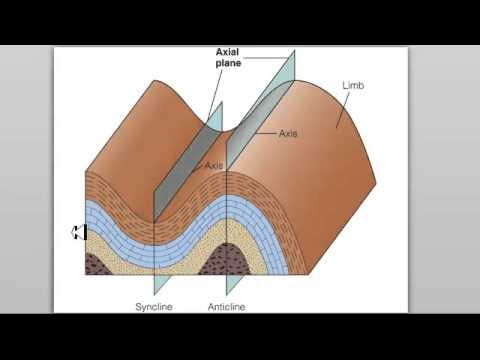How do rocks fold?
Summary
TLDRThe video explores the various ways rocks fold during deformation, focusing on buckling, flexural slip, and different mechanisms that influence fold structures. It explains the difference between hinges and limbs, showing how layer thickness, viscosity, and mechanical properties impact fold shapes. The video covers single and multi-layer folds, parasitic folds, and how forces like shear zones and fault movements create forced folds. By examining these processes, the video highlights how these structures reveal the conditions and mechanical behavior of rocks during tectonic evolution.
Takeaways
- 🪨 Rocks can either fold or break during deformation, leading to different structural outcomes.
- 🔄 The process of folding can produce various shapes and occur at different scales, with the difference between hinges and limbs being important.
- 🌀 Buckling is a significant mechanism in rock folding, especially in single-layer and multi-layer sequences, similar to a stack of paper.
- ✋ Tangential longitudinal strain is a folding process where the outer arc stretches and the inner arc contracts, much like bending a finger.
- 📚 Flexural slip occurs along bedding planes, where layers slide past each other, much like pages of a book.
- ⚖️ Layer thickness and viscosity contrast are crucial factors that determine the wavelength and folding behavior, as seen in experiments and natural formations.
- 🦴 Parasitic folds, which are smaller folds sitting on larger ones, develop due to variations in layer thickness and deformation.
- 🌊 Viscosity contrast between rock layers can lead to different fold structures, such as mullions, where layers with different viscosities create pinched and bulbous shapes.
- 🌍 Forced folds arise from external processes, like fault movements or salt doming, rather than direct buckling.
- 🛠 Shear folding occurs when layers are caught in shear zones, leading to folding as the surrounding rocks move past each other.
Q & A
What is the difference between hinges and limbs in fold structures?
-In fold structures, the hinge is the part of the fold where the curvature is greatest, while the limbs are the parts of the fold that extend outward on either side of the hinge, showing less curvature.
How does tangential longitudinal strain contribute to folding?
-Tangential longitudinal strain involves the outer arc of the fold stretching and the inner arc contracting, allowing the rock to fold without distorting the limbs. This process is similar to bending a finger, where the outside stretches and the inside contracts.
What is flexural slip and how does it contribute to folding?
-Flexural slip occurs when layers of rock slip along bedding planes, allowing folds to develop. There is no slip at the hinge, but the layers slip past each other, helping to accommodate the fold.
What is buckle folding and what controls its development?
-Buckle folding forms due to layer-parallel contraction. The development of buckle folds is controlled by the layer thickness and the viscosity contrast between the folded layer and the surrounding material. Thicker layers form longer wavelength folds, while thinner layers form shorter wavelength folds.
What are parasitic folds and how do they form?
-Parasitic folds are smaller folds that form on the limbs of larger folds. They arise when a higher viscosity layer folds early in the deformation process, and then gets refolded by the subsequent development of larger structures.
How does the relative viscosity between layers affect fold formation?
-When a layer has a higher viscosity than its surrounding material, it tends to form folds with longer wavelengths. If the layer has a lower viscosity, it creates more pinched-in, narrow fold structures called mullions.
What kind of folds develop in rocks with fine layering or anisotropy?
-Rocks with fine layering or anisotropy tend to develop kink folds, which have sharp hinges and straight limbs. These folds are typically formed through flexural slip.
How do forced folds differ from buckle folds?
-Forced folds are created by external forces, such as movement along a fault or the upward movement of a salt dome, rather than by buckling due to layer-parallel compression. The fold develops as a result of the shape or displacement caused by the external force.
What is shear entrainment and how does it cause folding?
-Shear entrainment occurs when a layer of rock is caught within a zone of shear, causing it to fold as the two sides of the shear zone move past each other. This creates folds that are characteristic of similar folds.
What do fold structures reveal about the mechanical properties and deformation conditions of rocks?
-Fold structures can indicate the relative viscosity, strength, and anisotropy of the rocks, as well as the forces that were acting on them during deformation. By studying folds, geologists can deduce the tectonic evolution and deformation history of a region.
Outlines

Dieser Bereich ist nur für Premium-Benutzer verfügbar. Bitte führen Sie ein Upgrade durch, um auf diesen Abschnitt zuzugreifen.
Upgrade durchführenMindmap

Dieser Bereich ist nur für Premium-Benutzer verfügbar. Bitte führen Sie ein Upgrade durch, um auf diesen Abschnitt zuzugreifen.
Upgrade durchführenKeywords

Dieser Bereich ist nur für Premium-Benutzer verfügbar. Bitte führen Sie ein Upgrade durch, um auf diesen Abschnitt zuzugreifen.
Upgrade durchführenHighlights

Dieser Bereich ist nur für Premium-Benutzer verfügbar. Bitte führen Sie ein Upgrade durch, um auf diesen Abschnitt zuzugreifen.
Upgrade durchführenTranscripts

Dieser Bereich ist nur für Premium-Benutzer verfügbar. Bitte führen Sie ein Upgrade durch, um auf diesen Abschnitt zuzugreifen.
Upgrade durchführen5.0 / 5 (0 votes)






